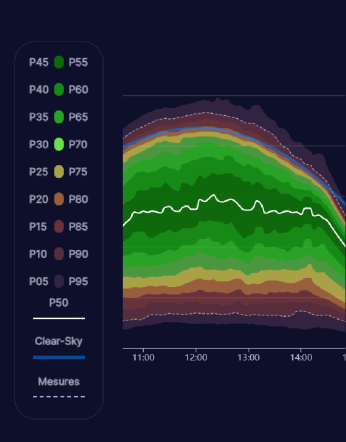Solar energy producers: Utilities and IPPs


Optimize the management of your photovoltaic power plants with intraday and day-ahead forecasts
REDUCE FORECAST DEVIATION AND IMBALANCE PENALTIES

Solar forecasting to reduce financial penalties for solar power plants
To limit the financial penalties associated with the discrepancy between forecasted and real power production, photovoltaic power plants need reliable D+1 and intra-day forecasts. By combining meteorological models, high spatial resolution satellite images and existing on-site data, it is possible to obtain a more accurate view of future production.
Integration of real-time irradiance and on-site power production data enables forecasts to be refined. Using this approach the accuracy of NEXT gets improved by up to +46% compared to the use of meteorological models alone.
Nowcasting to reduce penalties in complex climates

Diminution of forecast deviation penalties
In complex climatic contexts - island, tropical, high-altitude or affected by the monsoon - conventional forecasts are not enough. Weather conditions are localized and changeable, requiring real-time observation of the sky.
Calibsun offers a nowcasting solution based on a network of hemispherical cameras and sensors installed directly on site. Unlike a single camera, this network provides a three-dimensional view of the clouds, offering a highly accurate, minute-by-minute estimate of expected solar power production.
This industry-first technological solution enables anticipation of drops in production due to cloud cover, which is essential for operators faced with high climate variability.
IMPROVE OPERATIONAL MANAGEMENT

Solar Energy Storage Forecasting and Planning
Integrating irradiance and production forecasts into an Energy Management System (EMS) helps minimize energy losses and increase the profitability of photovoltaic assets. The forecasts help the EMS anticipate energy storage and release phases based on supply and demand. This improves energy efficiency and maximizes the profitability of the photovoltaic plant.
Photovoltaic energy production scenarios for strategies tailored to needs
NEXT offers probabilistic scenarios, from P90 to P05, supplemented by a deterministic P50 forecast. This combination provides a comprehensive understanding of meteorological uncertainties and allows for better planning of decisions related to energy resale or storage, adapting to market conditions.


 en
en 
 fr
fr es
es de
de